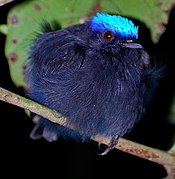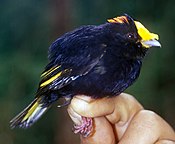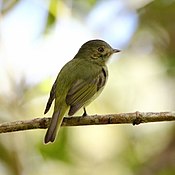Manakin: Perbedaan antara revisi
Dibuat dengan menerjemahkan halaman "Manakin" |
Tidak ada ringkasan suntingan |
||
| Baris 13: | Baris 13: | ||
== Perilaku dan ekologi == |
== Perilaku dan ekologi == |
||
{{Cladogram|caption= |
{{Cladogram|caption=Filogeni berdasarkan studi [[suboscine]] oleh Michael Harvey dan rekan-rekan yang diterbitkan pada tahun 2020. Genera ''[[Chiroxiphia]]'' dan ''[[Neopelma]]'' ditemukan sebagai [[paraphyletic ]].<ref>{{Cite journal | last1=Harvey | first1=M.G. | last2=Bravo | first2=G.A. | last3=Claramunt | first3=S. | last4=Cuervo | first4=A.M. | last5=Derryberry | first5=G.E. | last6=Battilana | first6=J. | last7=Seeholzer | first7=G.F. | last8=McKay | first8=J.S. | last9=O’Meara | first9=B.C. | last10=Faircloth | first10=B.C. | last11=Edwards | first11=S.V. | last12=Pérez-Emán | first12=J. | last13=Moyle | first13=R.G. | last14=Sheldon | first14=F.H. | last15=Aleixo | first15=A. | last16=Smith | first16=B.T. | last17=Chesser | first17=R.T. | last18=Silveira | first18=L.F. | last19=Cracraft | first19=J. | last20=Brumfield | first20=R.T. | last21=Derryberry | first21=E.P. | date=2020 | title=The evolution of a tropical biodiversity hotspot | journal=Science | volume=370 | issue=6522 | pages=1343-1348 | doi=10.1126/science.aaz6970 }}</ref>|align=right|cladogram={{Cladex| style=font-size:80%;line-height:75%;width:320px; |
||
|1={{clade |
|1={{clade |
||
|1={{clade |
|1={{clade |
||
|1=''[[Neopelma chrysolophum]]'' – Serra do Mar |
|1=''[[Neopelma chrysolophum]]'' – Manakin Serra do Mar |
||
|2={{clade |
|2={{clade |
||
|1=''[[Tyranneutes]]'' – 2 |
|1=''[[Tyranneutes]]'' – 2 spesies: Manakin tiran |
||
|2=''[[Neopelma]]'' – 4 |
|2=''[[Neopelma]]'' – 4 spesies: Manakin tiran |
||
}} |
}} |
||
}} |
}} |
||
| Baris 25: | Baris 25: | ||
|1={{clade |
|1={{clade |
||
|1={{clade |
|1={{clade |
||
|1=''[[Ilicura]]'' – |
|1=''[[Ilicura]]'' – Manakin berekor jarum |
||
|2={{clade |
|2={{clade |
||
|1=''[[Masius]]'' – |
|1=''[[Masius]]'' – Manakin bersayap emas |
||
|2=''[[Corapipo]]'' – 3 |
|2=''[[Corapipo]]'' – 3 spesies |
||
}} |
}} |
||
}} |
}} |
||
|2=''[[Chiroxiphia]]'' – 5 |
|2=''[[Chiroxiphia]]'' – 5 spesies dengan ''[[Antilophia]]'' – 2 spesies |
||
}} |
}} |
||
|2={{clade |
|2={{clade |
||
|1=''[[Xenopipo]]'' – 2 |
|1=''[[Xenopipo]]'' – 2 spesies |
||
|2={{clade |
|2={{clade |
||
|1=''[[Chloropipo]]'' – 2 |
|1=''[[Chloropipo]]'' – 2 spesies |
||
|2={{clade |
|2={{clade |
||
|1={{clade |
|1={{clade |
||
|1=''[[Cryptopipo]] – |
|1=''[[Cryptopipo]] – Manakin hijau |
||
|2=''[[Lepidothrix]]'' – 8 |
|2=''[[Lepidothrix]]'' – 8 spesies |
||
}} |
}} |
||
|2={{clade |
|2={{clade |
||
|1={{clade |
|1={{clade |
||
|1=''[[Heterocercus]]'' – 3 |
|1=''[[Heterocercus]]'' – 3 spesies |
||
|2=''[[Manacus]]'' – 4 |
|2=''[[Manacus]]'' – 4 spesies |
||
}} |
}} |
||
|2={{clade |
|2={{clade |
||
|1=''[[Pipra]]'' – 3 |
|1=''[[Pipra]]'' – 3 spesies |
||
|2={{clade |
|2={{clade |
||
|1=''[[Machaeropterus]]'' – 5 |
|1=''[[Machaeropterus]]'' – 5 spesies |
||
|2={{clade |
|2={{clade |
||
|1=''[[Pseudopipra]]'' – |
|1=''[[Pseudopipra]]'' – Manakin bermahkota putih |
||
|2=''[[Ceratopipra]]'' – 5 |
|2=''[[Ceratopipra]]'' – 5 spesies |
||
}} |
}} |
||
}} |
}} |
||
| Baris 64: | Baris 64: | ||
}} |
}} |
||
}}}} |
}}}} |
||
{{Cladogram|caption=Phylogeny based on a study of the [[suboscine]]s by Michael Harvey and colleagues published in 2020. The genera ''[[Chiroxiphia]]'' and ''[[Neopelma]]'' were found to be [[paraphyletic]].<ref>{{Cite journal | last1=Harvey | first1=M.G. | last2=Bravo | first2=G.A. | last3=Claramunt | first3=S. | last4=Cuervo | first4=A.M. | last5=Derryberry | first5=G.E. | last6=Battilana | first6=J. | last7=Seeholzer | first7=G.F. | last8=McKay | first8=J.S. | last9=O’Meara | first9=B.C. | last10=Faircloth | first10=B.C. | last11=Edwards | first11=S.V. | last12=Pérez-Emán | first12=J. | last13=Moyle | first13=R.G. | last14=Sheldon | first14=F.H. | last15=Aleixo | first15=A. | last16=Smith | first16=B.T. | last17=Chesser | first17=R.T. | last18=Silveira | first18=L.F. | last19=Cracraft | first19=J. | last20=Brumfield | first20=R.T. | last21=Derryberry | first21=E.P. | date=2020 | title=The evolution of a tropical biodiversity hotspot | journal=Science | volume=370 | issue=6522 | pages=1343-1348 | doi=10.1126/science.aaz6970 }}</ref>|align=right|cladogram={{Cladex| style=font-size:80%;line-height:75%;width:320px; |
|||
|1={{clade |
|||
|1={{clade |
|||
|1=''[[Neopelma chrysolophum]]'' – Serra do Mar tyrant-manakin |
|||
|2={{clade |
|||
|1=''[[Tyranneutes]]'' – 2 species: tyrant-manakins |
|||
|2=''[[Neopelma]]'' – 4 species: tyrant-manakins |
|||
}} |
|||
}} |
|||
|2={{clade |
|||
|1={{clade |
|||
|1={{clade |
|||
|1=''[[Ilicura]]'' – pin-tailed manakin |
|||
|2={{clade |
|||
|1=''[[Masius]]'' – golden-winged manakin |
|||
|2=''[[Corapipo]]'' – 3 species |
|||
}} |
|||
}} |
|||
|2=''[[Chiroxiphia]]'' – 5 species with ''[[Antilophia]]'' – 2 species |
|||
}} |
|||
|2={{clade |
|||
|1=''[[Xenopipo]]'' – 2 species |
|||
|2={{clade |
|||
|1=''[[Chloropipo]]'' – 2 species |
|||
|2={{clade |
|||
|1={{clade |
|||
|1=''[[Cryptopipo]] – green manakin |
|||
|2=''[[Lepidothrix]]'' – 8 species |
|||
}} |
|||
|2={{clade |
|||
|1={{clade |
|||
|1=''[[Heterocercus]]'' – 3 species |
|||
|2=''[[Manacus]]'' – 4 species |
|||
}} |
|||
|2={{clade |
|||
|1=''[[Pipra]]'' – 3 species |
|||
|2={{clade |
|||
|1=''[[Machaeropterus]]'' – 5 species |
|||
|2={{clade |
|||
|1=''[[Pseudopipra]]'' – white-crowned manakin |
|||
|2=''[[Ceratopipra]]'' – 5 species |
|||
}} |
|||
}} |
|||
}} |
|||
}} |
|||
}} |
|||
}} |
|||
}} |
|||
}} |
|||
}} |
|||
}}}} |
|||
=== Makanan === |
=== Makanan === |
||
Manakins memakan tumbuhan dan buah-buahan kecil (tetapi sering kali sangat besar untuk ukuran burung).<ref name="HBW2">Snow, D. W. (2004). Family Pipridae (Manakins). Pp. 110-169 in: del Hoyo, J., Elliott, A., & Christie, D. A. eds (2004). ''Handbook of the Birds of the World.'' Vol. 9. Cotingas to Pipits and Wagtails. Lynx Edicions, Barcelona. {{ISBN|84-87334-69-5}}</ref> Karena mereka mengambil buah sambil terbang seperti halnya [[elang]] terhadap serangga, mereka diyakini telah berevolusi dari burung pemakan serangga. Betina memiliki wilayah yang luas. Jantan menghabiskan sebagian besar waktu mereka bersama di lokasi "pertemuan dengan betina."<ref name="P&S2">{{cite book|last=Prum|first=Richard O.|author2=Snow, David W.|year=2003|url=https://archive.org/details/fireflyencyclope0000unse/page/434|title=The Firefly Encyclopedia of Birds|publisher=Firefly Books|isbn=978-1-55297-777-4|editor=Perrins, Christopher|editor-link=Chris Perrins|pages=[https://archive.org/details/fireflyencyclope0000unse/page/434 434–437]|chapter=Manakins|chapter-url=https://archive.org/details/fireflyencyclope0000unse|chapter-url-access=registration}}</ref> |
Manakins memakan tumbuhan dan buah-buahan kecil (tetapi sering kali sangat besar untuk ukuran burung).<ref name="HBW2">Snow, D. W. (2004). Family Pipridae (Manakins). Pp. 110-169 in: del Hoyo, J., Elliott, A., & Christie, D. A. eds (2004). ''Handbook of the Birds of the World.'' Vol. 9. Cotingas to Pipits and Wagtails. Lynx Edicions, Barcelona. {{ISBN|84-87334-69-5}}</ref> Karena mereka mengambil buah sambil terbang seperti halnya [[elang]] terhadap serangga, mereka diyakini telah berevolusi dari burung pemakan serangga. Betina memiliki wilayah yang luas. Jantan menghabiskan sebagian besar waktu mereka bersama di lokasi "pertemuan dengan betina."<ref name="P&S2">{{cite book|last=Prum|first=Richard O.|author2=Snow, David W.|year=2003|url=https://archive.org/details/fireflyencyclope0000unse/page/434|title=The Firefly Encyclopedia of Birds|publisher=Firefly Books|isbn=978-1-55297-777-4|editor=Perrins, Christopher|editor-link=Chris Perrins|pages=[https://archive.org/details/fireflyencyclope0000unse/page/434 434–437]|chapter=Manakins|chapter-url=https://archive.org/details/fireflyencyclope0000unse|chapter-url-access=registration}}</ref> |
||
Revisi per 14 Januari 2021 02.22
| Manakin
| |
|---|---|
| Pipridae | |
| Taksonomi | |
| Kelas | Aves |
| Ordo | Passeriformes |
| Famili | Pipridae Rafinesque, 1815 |
| Distribusi | |
 | |
Manakin adalah keluarga dari burung pengicau kecil. Kelompok ini terdiri dari 60 spesies yang tersebar di daerah tropis Amerika. Namanya berasal dari mannekijn dalam bahasa Belanda yang berarti "pria kecil".
Deskripsi
Ukurannya berkisar dari 7 hingga 15 cm (3 hingga 6 inci) dan beratnya dari 8 hingga 30 g (0,28 hingga 1,06 oz). Genus Tyranneutes terdiri dari manakin terkecil, genus Antilophia diyakini sebagai yang terbesar (karena genus Schiffornis tidak lagi dianggap manakin). Mereka adalah burung gemuk dengan ekor pendek, sayap lebar dan bulat, dan kepala besar. Tagihannya pendek dan memiliki celah yang lebar. Betina dan jantan memiliki bulu hijau kusam di tahun pertama.[1] Jantan kebanyakan berwarna hitam dengan warna mencolok pada bercak.[2] Pada beberapa spesies, jantan yang berumur dua sampai empat tahun memiliki bulu yang khas.[1]
Syrinx atau "kotak suara" pada manakin unik, membedakan mereka dari famili terdekat seperti Cotingidae dan Tyrannidae. Selain itu, variasi dalam kelompok ini menyebabkan genera atau bahkan spesies dapat diidentifikasi hanya dengan syrinx, tidak seperti kebanyakan burung dari keluarga oscine. Suara yang dibuat adalah peluit, getar, dan dengungan.[1]
Distribusi dan habitat
Manakin tinggal dari Meksiko selatan hingga Argentina utara, Paraguay, dan Brasil selatan, serta di Trinidad dan Tobago. Mereka sangat arboreal dan hampir secara eksklusif merupakan burung hutan. Sebagian besar spesies hidup di dataran rendah tropis yang lembab, dengan beberapa di hutan kering, sungai,[1] dan Andes.[3] Beberapa spesies dataran tinggi memiliki migrasi vertikal.
Perilaku dan ekologi
| |||||||||||||||||||||||||||||||||||||||||||||||||||||||||||||||||||||||||||||||||||||||||||||||||||
| Filogeni berdasarkan studi suboscine oleh Michael Harvey dan rekan-rekan yang diterbitkan pada tahun 2020. Genera Chiroxiphia dan Neopelma ditemukan sebagai paraphyletic .[4] |
Makanan
Manakins memakan tumbuhan dan buah-buahan kecil (tetapi sering kali sangat besar untuk ukuran burung).[3] Karena mereka mengambil buah sambil terbang seperti halnya elang terhadap serangga, mereka diyakini telah berevolusi dari burung pemakan serangga. Betina memiliki wilayah yang luas. Jantan menghabiskan sebagian besar waktu mereka bersama di lokasi "pertemuan dengan betina."[1]
Reproduksi
Banyak spesies manakin memiliki ritual rayuan lek yang spektakuler, yang khususnya rumit dalam genera Pipra dan Chiroxiphia. Anggota genera Machaeropterus dan Manacus memiliki bulu sayap yang dimodifikasi besar-besaran, yang mereka gunakan untuk membuat suara berdengung dan patah.
Pembuatan sarang (cawan terbuka, umumnya pada vegetasi rendah), inkubasi selama 18 hingga 21 hari, dan perawatan anak selama 13 hingga 15 hari dilakukan oleh betina saja. Karena kebanyakan manakin tidak membentuk pasangan yang stabil (Burung manakin ber-helm memang berpasangan, tetapi kontribusi jantan terbatas untuk mempertahankan wilayah). Jumlah telur normal adalah dua telur, yang berwarna putih kekuningan dan kusam, ditandai dengan warna coklat.[1]
Daftar spesies
Keluarga Pipridae diperkenalkan (sebagai Pipraria) oleh polimatik Prancis Constantine Samuel Rafinesque pada tahun 1815.[5][6] Anggota genus Schiffornis sebelumnya dimasukan dalam keluarga ini, tetapi sekarang ditempatkan di Tityridae.[7]
| Image | Genus | Living Species |
|---|---|---|

|
Pseudopipra Kirwan et al, 2016 |
|

|
Pipra Linnaeus, 1764 |
|

|
Ceratopipra Bonaparte, 1854 |
|

|
Lepidothrix Bonaparte, 1854 |
|

|
Antilophia L. Reichenbach, 1850 |
|

|
Chiroxiphia Cabanis, 1847 |
|

|
Ilicura L. Reichenbach, 1850 |
|

|
Masius Bonaparte, 1850 |
|

|
Corapipo Bonaparte, 1854 |
|

|
Manacus Brisson, 1760 |
|

|
Machaeropterus Hahn, 1819 |
|
| Xenopipo Cabanis, 1847 |
| |

|
Cryptopipo Ohlson et al., 2013 |
|
| Chloropipo Cabanis & Heine, 1859 |
| |

|
Heterocercus Strickland, 1850 |
|

|
Neopelma P.L. Sclater, 1861 |
|

|
Tyranneutes P.L. Sclater & Salvin, 1881 |
|
Referensi
- ^ a b c d e f Prum, Richard O.; Snow, David W. (2003). "Manakins"
 . Dalam Perrins, Christopher. The Firefly Encyclopedia of Birds. Firefly Books. hlm. 434–437. ISBN 978-1-55297-777-4.
. Dalam Perrins, Christopher. The Firefly Encyclopedia of Birds. Firefly Books. hlm. 434–437. ISBN 978-1-55297-777-4.
- ^ Lanyon, Scott N. (1991). Forshaw, Joseph, ed. Encyclopaedia of Animals: Birds. London: Merehurst Press. hlm. 167–168. ISBN 978-1-85391-186-6.
- ^ a b Snow, D. W. (2004). Family Pipridae (Manakins). Pp. 110-169 in: del Hoyo, J., Elliott, A., & Christie, D. A. eds (2004). Handbook of the Birds of the World. Vol. 9. Cotingas to Pipits and Wagtails. Lynx Edicions, Barcelona. ISBN 84-87334-69-5
- ^ Harvey, M.G.; Bravo, G.A.; Claramunt, S.; Cuervo, A.M.; Derryberry, G.E.; Battilana, J.; Seeholzer, G.F.; McKay, J.S.; O’Meara, B.C.; Faircloth, B.C.; Edwards, S.V.; Pérez-Emán, J.; Moyle, R.G.; Sheldon, F.H.; Aleixo, A.; Smith, B.T.; Chesser, R.T.; Silveira, L.F.; Cracraft, J.; Brumfield, R.T.; Derryberry, E.P. (2020). "The evolution of a tropical biodiversity hotspot". Science. 370 (6522): 1343–1348. doi:10.1126/science.aaz6970.
- ^ Rafinesque, Constantine Samuel (1815). Analyse de la nature ou, Tableau de l'univers et des corps organisés (dalam bahasa French). Palermo: Self-published. hlm. 66.
- ^ Bock, Walter J. (1994). History and Nomenclature of Avian Family-Group Names. Bulletin of the American Museum of Natural History. Number 222. New York: American Museum of Natural History. hlm. 149, 252. hdl:2246/830.
- ^ Remsen, J. V., Jr., C. D. Cadena, A. Jaramillo, M. Nores, J. F. Pacheco, M. B. Robbins, T. S. Schulenberg, F. G. Stiles, D. F. Stotz, & K. J. Zimmer. 2007. A classification of the bird species of South America. Diarsipkan 2009-03-02 di Wayback Machine. American Ornithologists' Union. Accessed 12 December 2007.
Bacaan tambahan
- Ohlson, J.I.; Fjeldså, J.; Ericson, P.G.P. (2013). "Molecular phylogeny of the manakins (Aves: Passeriformes: Pipridae), with a new classification and the description of a new genus". Molecular Phylogenetics and Evolution. 69 (3): 796–804. doi:10.1016/j.ympev.2013.06.024. PMID 23831559.
Pranala luar
- "Jungle Dancers", Nature artikel tentang perilaku manakin, dari situs PBS
- "High-speed videos of two manakin clades (Pipridae: Aves)", dari situs web Journal of Experimental Biology
- Videos of Machaeropterus deliciosus making a "tick-tick-ting" sound through wing motion, dari situs web Science
- Manakin videos, photos and sounds di Internet Bird Collection
- "Manakins and the Plant Family Melastomataceae", dari situs web Ecology Online Sweden

